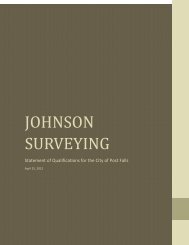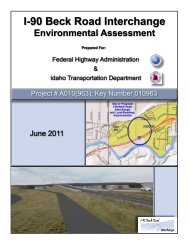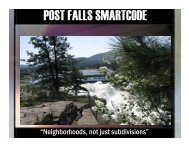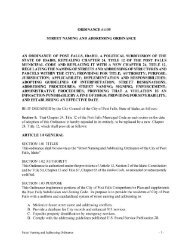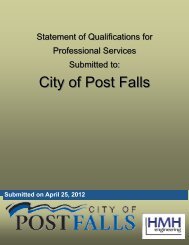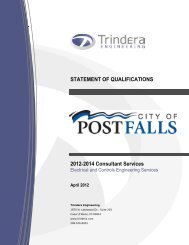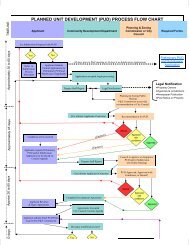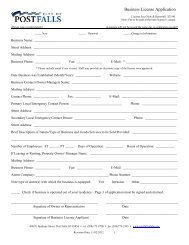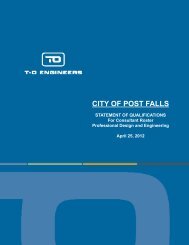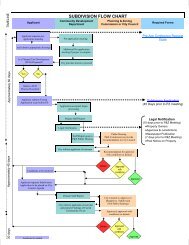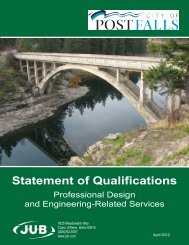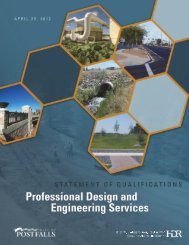Preferred Trees List - City of Post Falls
Preferred Trees List - City of Post Falls
Preferred Trees List - City of Post Falls
You also want an ePaper? Increase the reach of your titles
YUMPU automatically turns print PDFs into web optimized ePapers that Google loves.
What’s Hot & What’s Not<br />
in the World <strong>of</strong> Urban Foresters<br />
<strong>Post</strong> <strong>Falls</strong> Urban Forestry Division<br />
<strong>City</strong> <strong>of</strong> <strong>Post</strong> <strong>Falls</strong>, ID
What’s Hot?
Pin Oak<br />
(Quercus palustris)
Pin Oak<br />
(Quercus palustris)<br />
• Named for the large number <strong>of</strong> "pin‐like" or spur‐like fine lateral branches, this large, deciduous shade tree displays a<br />
uniform pyramidal habit with a dominant central leader.<br />
• Habit/Form: Uniformly pyramidal with a straight central leader; the upper branches ascending and the lower ones distinctly<br />
descending.<br />
• Size: 60 to 70' high, 40 to 50’ wide.<br />
• Color: Glossy dark green; light green to yellow‐green if suffering from iron chlorosis. Fall color varies from bright red to dull<br />
brown.<br />
• Insect/Disease Factors: Over plantings can encourage problems, such as gypsy moth, oak wilt, galls and cankers. Resistant to<br />
anthracnose.<br />
• Hardiness: Zone 4b USDA<br />
• Growth Rate: Fast<br />
• Ornamental Features: Striking excurrent form and very showy when fall color is good.
Scarlet Oak<br />
(Quercus coccinea)
Scarlet Oak<br />
(Quercus coccinea)<br />
• A large deciduous oval to rounded tree known for its excellent scarlet fall color.<br />
• Habit/Form: Oval to rounded with an open habit.<br />
• Size: 70 to 75' high, 40 to 50’ wide<br />
• Color: Glossy dark green. Impressive orange to red fall color.<br />
• Insect/Disease Factors: None that are serious or limiting.<br />
• Hardiness: Zone 5a USDA<br />
• Growth Rate: Relatively slow.<br />
• Ornamental Features: Very striking fall color, acorns.<br />
• Notable Alternative: Red oak (Quercus rubra)
Heritage Birch<br />
(Betula nigra)
Heritage Birch<br />
(Betula nigra ‘Heritage’)<br />
• This selection <strong>of</strong> river birch has outstanding exfoliating bark in various shades <strong>of</strong> white to salmon‐white, becoming tan‐white.<br />
It is more vigorous than the species and appears to be more pest tolerant. Heritage is the registered trademarked name for<br />
the cultivar 'Cully', discovered by Earl Cully <strong>of</strong> Jacksonville, Illinois.<br />
• Habit/Form: Broadly pyramidal to oval, vigorous grower, multi‐stem or single stem forms available, ‘Dura‐Heat’ has dense<br />
compact appearance.<br />
• Size: 40 to 50’ high, 30 to 40’ wide.<br />
• Color: Glossy light green on the upper side <strong>of</strong> leaf and pubescent white on the under side. Leaves turn yellow in the fall.<br />
• Insect/Disease Factors: Resistant to bronze birch borer, less prone to leaf‐spot than the species. ‘Dura Heat’ is aphid<br />
resistant.<br />
• Hardiness: Zone 4b (4a) USDA<br />
• Growth Rate: Medium to fast.<br />
• Ornamental Features: The exfoliating bark is the most outstanding feature, slender dark brown catkins.<br />
• Notable Alternative: A really good alternative to Heritage Birch is the Turkish Filbert (Corylus colurna).
European Beech<br />
(Fagus sylvatica)
European Beech<br />
(Fagus sylvatica)<br />
• An oval to rounded shade tree with a beautiful smooth gray bark and numerous cultivated selections for foliage and habit<br />
variations.<br />
• Habit/Form: Pyramidal in youth becoming oval to rounded with age, uniform<br />
• Size: 40‐60' high, 35 to 45’ wide.<br />
• Color: Light to dark green in the summer, turning to a mixture <strong>of</strong> gold/orange/bronze in the fall. Impressive fall color on<br />
mature trees.<br />
• Insect/Disease Factors: Susceptible to beech bark disease, cankers, powdery mildew and leaf spots.<br />
• Hardiness: Zone 5a USDA<br />
• Growth Rate: Slow to moderate.<br />
• Ornamental Features: Smooth grey bark, fruit pods, large buttress roots.
Norway Spruce<br />
(Picea abies)
Norway Spruce<br />
(Picea abies)<br />
• Cultivated for many centuries, this popular and graceful evergreen tree boasts a pyramidal habit with pendulous older<br />
branches, rich dark green color and an impressive size. It has been widely planted all over the world.<br />
• Habit/Form: Tall pyramidal with a straight central leader, horizontal lateral branches, and distinctly pendulous tertiary<br />
branches; it tends to lose its form and lower branches with age.<br />
• Size: 60‐90' high in the landscape, 130‐215' in native range, 30 to 40’ wide.<br />
• Color: Deep green<br />
• Insect/Disease Factors: None serious.<br />
• Hardiness: Zone 3a USDA, but not adapted beyond zone 7 due to heat.<br />
• Growth Rate: Fast at 2‐3 feet per year on average.<br />
• Ornamental Features: Pendulous foliage on large ascending branches; large slender cones hanging from branches.
Kentucky C<strong>of</strong>feetree<br />
(Gymnocladus dioicus)
Kentucky C<strong>of</strong>feetree<br />
(Gymnocladus dioicus)<br />
• A large oval deciduous tree with bipinnately compound leaves and good cultural adaptability. The genus name means "naked<br />
branch", a feature which gives the plant a very bare and bold or picturesque winter appearance.<br />
• Habit/Form: Oval with coarse branching, picturesque<br />
• Size: 60‐75' high, 40 to 50’ wide.<br />
• Color: Emerges late spring with pinkish‐purplish tinge, changing to blue‐green in summer, and a potentially good yellow fall<br />
color.<br />
• Insect/Disease Features: Relatively pest free.<br />
• Hardiness: Zone 4a USDA<br />
• Growth Rate: Medium<br />
• Ornamental Features: The flower has greenish‐white or yellowish‐white pyramidal clusters, late spring, 8‐12” on female<br />
trees, 3‐4” on male trees, female has a rose fragrance. The bark is a rough grey to dark brown, with hard thin and scaly<br />
ridges curling outward, exposing an orange/brown color.
Black Tupelo<br />
(Nyssa sylvatica)
Black Tupelo<br />
(Nyssa sylvatica)<br />
• Nyssa sylvatica, commonly known as black tupelo, tupelo, or black gum, is a medium‐sized deciduous tree native to eastern<br />
North America from New England and southern Ontario south to central Florida and eastern Texas, as well as Mexico.<br />
• Habit/Form: Pyramidal in youth, becoming rounded pyramidal; it has a central leader with numerous small‐diameter lateral<br />
branches radiating from the trunk at right angles like spokes on a wheel when viewed from below.<br />
• Size: 30‐60' high, 20 to 40’ wide.<br />
• Color: Dark glossy green in the summer, turning to a complete spectrum <strong>of</strong> fall colors.<br />
• Insect/Disease Factors: None serious.<br />
• Hardiness: Zone 5a USDA<br />
• Growth Rate: Slow to medium.<br />
• Ornamental Features: Spectacular fall colors, perfect excurrent form when young, no hassles.<br />
• Notable Alternative: Persian Parrotia (Parrotia persica).
Chinkapin Oak<br />
(Quercus muehlenbergii)
Chinkapin Oak<br />
(Quercus muehlenbergii)<br />
• A medium to large rounded to broad‐rounded deciduous tree whose lumber was extensively used for railroad ties in the early<br />
days <strong>of</strong> the railroad in the US.<br />
• Habit/Form: Initially rounded, becoming broad‐rounded with age; wide open branch angles.<br />
• Size: 40 to 50' high, sometimes larger, 30 to 60’ wide.<br />
• Color: Dark, glossy green in summer, turning to a somewhat dull orange/brown in the fall.<br />
• Insect/Disease Features: None serious.<br />
• Hardiness: Zone 5a USDA<br />
• Growth Rate: Medium in youth, slow with age.<br />
• Ornamental Features: Very interesting serrated leaf, rough and flaky bark, showy 3‐4” long male catkins, acorns.
Japanese Zelkova<br />
(Zelkova serrata)
Japanese Zelkova<br />
(Zelkova serrata)<br />
• Distinctly vase‐shaped and rounded, this large Asian deciduous tree features a medium‐fine texture and interesting fall color.<br />
• Habit/Form: Vase‐shaped and rounded, arching, heavily branched low in the crown, densely crowded with narrow‐angled<br />
branches.<br />
• Size: 50‐90' high, 40 to 60’ wide.<br />
• Color: Dark green in summer, turning to combinations <strong>of</strong> russet‐yellow, brown, yellow, orange, red, purple.<br />
• Insect/Disease Factors: None serious.<br />
• Hardiness: Zone 5b USDA<br />
• Growth Rate: Medium, possibly fast in youth.<br />
• Ornamental Features: Attractive form, bark is extremely ornamental, reddish brown and cherry‐like in youth, exfoliates and<br />
mottles with age in oranges, greys and browns.
Katsura Tree<br />
(Cercidiphyllum japonicum)
Katsura Tree<br />
(Cercidiphyllum japonicum)<br />
• A handsome, medium sized deciduous tree with attractive bluish‐green leaves that are purplish when emerging and<br />
developing potentially good orange‐yellow fall color.<br />
• Habit/Form: Rounded‐pyramidal if several trunks, narrower if grown with a single trunk.<br />
• Size: 40 to 60' high, 20 to 40’ wide.<br />
• Color: New leaves reddish purple changing to bluish green in summer.<br />
• Insect/Disease Factors: None serious.<br />
• Hardiness: Zone 5a USDA<br />
• Growth Rate: Medium to fast.<br />
• Ornamental Features: Interesting ½ to ¾” seed pod, graceful form, stunning, though short‐lived, fall display.
Blue Giant Sequoia<br />
(Sequoiadendron giganteum ‘Glaucum’)
Blue Giant Sequoia<br />
(Sequoiadendron giganteum ‘Glaucum’)<br />
• A rare selection with steel‐blue foliage and chestnut red bark when established, Sequoiadendron giganteum 'Glaucum' also<br />
seems to have a slightly more narrow habit than the species Sequoiadendron giganteum when young.<br />
A spectacular and unusual cultivar with fetching blue‐grey foliage.<br />
• Habit/Form: Narrow pyramidal, with a strong central leader and uniformly dense foliage that is sharply scaly and cord‐like; is<br />
beautifully tapered, with a wide base (not as wide as the species) and a perfect central leader, unlike the species.<br />
• Size: 50 to 90' high, 20 to 30’ wide.<br />
• Color: Light bluish green.<br />
• Insect/Disease Factors: None serious.<br />
• Hardiness: Zone 6 –9 USDA. This zone classification does not seem to be accurate. The ‘Blue Giant’ grows quite happily in<br />
zone 5.<br />
• Growth Rate: Medium to fast.<br />
• Ornamental Features: Attractive bluish/green color, very uniform, hassle‐free. Ideal for specimen plantings in city parks and<br />
other open spaces.
What’s Not!
Red Maple<br />
• The red<br />
(Acer rubrum)<br />
maple is just<br />
overplanted<br />
in this area.
Norway Maple<br />
(Acer platanoides)<br />
• Can become very invasive in<br />
naturalized areas <strong>of</strong> a city.
Silver Maple<br />
(Acer saccharinum)<br />
• Causes<br />
infrastruc<br />
ture<br />
problems<br />
with<br />
swales<br />
and tends<br />
to be<br />
hazardous<br />
in later<br />
years.
Sugar Maple<br />
(Acer saccharum)<br />
• Great for<br />
parks, etc.<br />
but not for<br />
swales,<br />
curbs and<br />
sidewalks.
Callery Pear<br />
(Pyrus calleryana)<br />
• Over-branching<br />
and included bark<br />
causes maintenance<br />
headache.
Cherry Plum<br />
(Prunus cerasifera)<br />
• Seriously<br />
overplanted.<br />
Fruit drop in<br />
late August<br />
is a street<br />
sweeper’s<br />
nightmare!
Honey Locust<br />
(Gleditsia triacanthos)<br />
• The overarching<br />
habit <strong>of</strong> the<br />
honey locust<br />
makes it an<br />
on going<br />
street<br />
maintenance<br />
project.
The What’s Not Hot <strong>List</strong><br />
• As a note to the above list, I do not mean to suggest that urban foresters do not like these trees. They are<br />
perfectly desirable trees in their own right and have many sought after attributes. As street trees, however,<br />
they do possess certain problems, and, for that reason, urban foresters are generally not interested in<br />
them.<br />
• In practice, what this means is, for example, when there is a new development <strong>of</strong> trees to be purchased,<br />
the urban forester will encourage the landscape architect to choose from the “What’s Hot <strong>List</strong>” rather<br />
than from the “What’s Not <strong>List</strong>”, thereby ensuring a proper species diversity for the urban forest.
What are some things Urban Foresters<br />
look for in nursery stock?<br />
• Quality <strong>of</strong> Material : Urban Foresters want the chance to inspect the tree at the nursery. This would include having a<br />
look at the root ball <strong>of</strong> the tree to be sure it has no visible signs <strong>of</strong> deformity, either from packaging or disease.<br />
• A strong central leader with well proportioned branching.<br />
• Free <strong>of</strong> insect and disease damage.<br />
• Roots that are not excessively root-bound.<br />
• A visible trunk flare above grade at the root crown.<br />
Nine times out <strong>of</strong> ten, urban foresters are frustrated by the fact that the tree’s root crown and trunk flare are covered by<br />
about 6” <strong>of</strong> compacted potting soil. Perhaps there is a practical need to cover the root ball and protect it from the elements,<br />
but when it comes time for planting, all <strong>of</strong> that compacted soil (which also has adventitious roots growing through it) make<br />
it difficult for planting the tree at the correct planting depth.<br />
• Caliper Size : Generally speaking, we do not get trees above 2” caliper, otherwise they are too heavy to plant on a large<br />
scale. Exceptions include specimen trees for parks, arboretums or special locations.<br />
• The cities <strong>of</strong> <strong>Post</strong> <strong>Falls</strong>, Coeur d’Alene and Hayden all have a minimum requirement <strong>of</strong> 1. 25” caliper for street trees. But,<br />
for special plantings, a tree up to 6” may be sought after.
What are Urban Foresters looking for from<br />
the Nursery Grower?<br />
• An Accommodating Grower:<br />
• Due to the large inventory <strong>of</strong> trees that we purchase, we want the grower to be willing to work with us on certain<br />
specifics, such as – holding the trees for extended periods <strong>of</strong> time; making sure trees are not heavily root-bound; informing<br />
us <strong>of</strong> any defects they might be aware <strong>of</strong>.<br />
• An Educated Grower:<br />
• As Bob Dylan once famously said: The times they are a changin’. We all need to be up to speed on the latest research on<br />
how trees grow and what helps them grow better. Urban foresters pay close attention to nursery growers who make efforts<br />
to attend educational workshops and who even change work practices to suit the latest tree research.<br />
• Follow up on Sales Pitch!<br />
• Keep sending us your inventories and prices.<br />
• The squeaky wheel gets the grease!<br />
• A superior product from one nursery will trump a lower cost tree from another. So, don’t be afraid if your trees seem to<br />
be a little over priced. If they are quality trees, we will go with your trees every time.
What are Nursery Growers Looking for<br />
from Urban Foresters?<br />
• Let us know what YOU need from us:<br />
• The above list <strong>of</strong> “hot” trees is by no means an exhaustive list <strong>of</strong> desirable trees <strong>of</strong> urban<br />
foresters. This list could easily have been quadrupled in size but for time restrictions.<br />
Please don’t hesitate to contact me with any questions:<br />
Brendan Murphy, Urban Forester<br />
408 N. Spokane St.<br />
<strong>Post</strong> <strong>Falls</strong>, ID 83854<br />
(208) 457-3315<br />
bmurphy@postfallsidaho.org<br />
www.postfallsidaho.org
end



